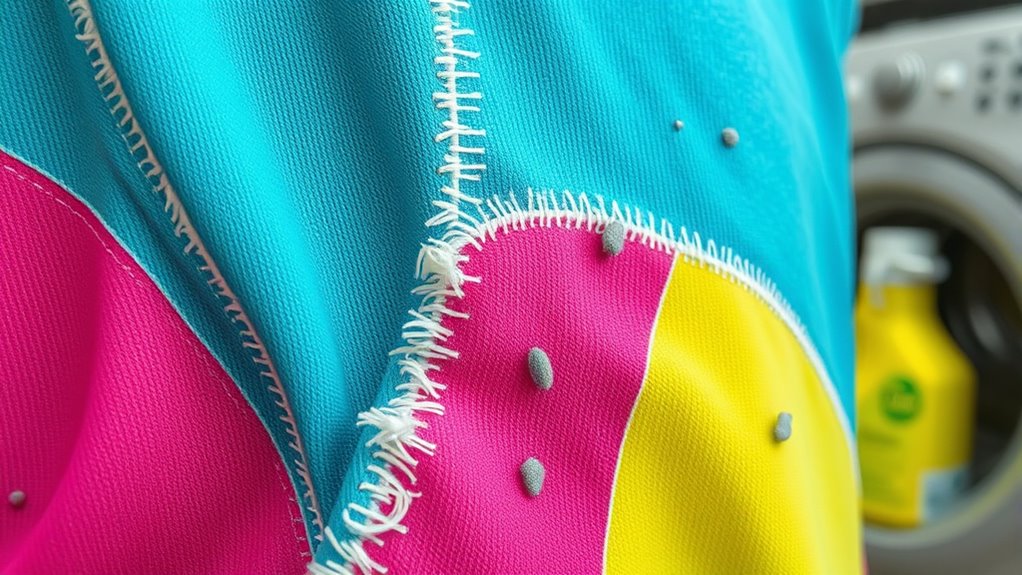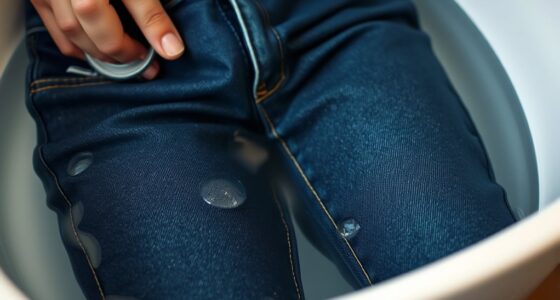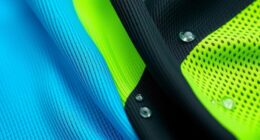If your activewear shows signs like fabric thinning, fading colors, lingering odors, or losing its stretch, your detergent might be to blame. Harsh chemicals break down fibers, cause surface pills, and weaken elastic parts over time. You might also notice small holes or a rough texture on your clothes. If these issues sound familiar, keep exploring to discover how to protect your gear and extend its lifespan effectively.
Key Takeaways
- Fabric becomes thin, prone to tears, or develops holes despite gentle washing.
- Colors fade or lose vibrancy, indicating dye damage from harsh chemicals.
- Persistent odors remain even after washing, due to residual detergent build-up.
- Elastic fibers weaken, causing activewear to lose its snug fit and elasticity.
- Surface pills or fuzz balls appear, signaling fiber breakdown from incompatible detergents.

Activewear is designed to withstand tough workouts and frequent washing, but your choice of detergent can secretly cause damage over time. One of the most noticeable signs is fabric deterioration. When you use the wrong detergent, it can break down the fibers of your activewear, making the fabric less durable and more prone to tearing or thinning. Over time, you might notice your leggings or moisture-wicking shirts becoming thinner or developing small holes, even if you treat them gently. This gradual weakening of the fabric is a direct result of harsh chemicals or residues left behind after washing, which compromise the material’s integrity.
Using the wrong detergent can weaken activewear fibers and cause damage over time.
Color fading is another common indicator that your detergent isn’t suitable for activewear. If your vibrant workout gear starts looking dull or washed-out after just a few washes, it’s a red flag. Many traditional detergents contain optical brighteners or harsh chemicals that strip away dyes and weaken color pigments. When this happens, your once-bright sports bras and compression tops lose their luster much faster than they should. This isn’t just a cosmetic issue; faded colors can also hint at underlying fiber damage, as the active ingredients in some detergents erode the dye molecules embedded in the fabric’s fibers.
You might also notice an increase in lingering odors even after washing. While some detergents claim to eliminate smells, many contain fragrances or chemicals that only mask odors temporarily. If your activewear smells musty or sweaty despite being washed regularly, it’s possible that the detergent isn’t rinsing out completely or is damaging the fabric’s natural ability to wick moisture and resist odors. This residual build-up can further accelerate fabric deterioration, making your gear less functional over time.
Another sign is the loss of elasticity in your activewear. If your leggings or tops lose their snug fit and feel looser after multiple washes, your detergent could be the culprit. Some harsh chemicals weaken elastic fibers, causing them to stretch out and lose their shape. This not only affects performance but also shortens the lifespan of your gear. Similarly, if you notice pills or fuzz balls forming on the surface of your activewear, it indicates that the fabric’s surface fibers are breaking down, often due to incompatible detergents.
Frequently Asked Questions
How Often Should I Wash My Activewear?
You should wash your activewear after every 1-3 wears, depending on your fabric blending and activity level. Frequent washing prevents odor buildup and maintains performance. For delicate blends, opt for gentle cycles and cold water. Avoid over-washing, which can wear out fibers faster. Pay attention to the fabric composition, and when in doubt, spot clean instead of full washes to extend the lifespan of your activewear.
Can Fabric Softeners Harm My Activewear?
Fabric softeners may seem helpful, but they can harm your activewear by causing material degradation and reducing elasticity. They leave residues that build up, making fabrics less breathable and more prone to wear and tear. You work hard at staying active, so don’t let softeners sabotage your gear. Instead, opt for gentle, sports-specific detergents to keep your activewear fresh, functional, and long-lasting.
What Water Temperature Is Best for Cleaning Activewear?
You should wash your activewear in cold water to protect its fibers. Cold water helps prevent fiber breakdown and keeps colors vibrant, reducing fading over time. Hot water might seem effective but can damage delicate fabrics, accelerating wear and tear. Always check your garment’s care label, but generally, cold water is best for maintaining the integrity and appearance of your activewear.
Are Natural Detergents Safer for Activewear?
Using natural detergents is like choosing a gentle rain over a thunderstorm—they’re safer for your activewear. They reduce environmental impact and are often free from harsh chemicals, making them safer for your skin and the planet. By opting for natural options, you keep your gear in top shape longer, while supporting a healthier environment. It’s a simple switch that benefits both your activewear and the world around you.
How Can I Prevent Odor Buildup in Activewear?
To prevent odor buildup in activewear, you should focus on odor prevention strategies like washing your clothes promptly after workouts and avoiding fabric softeners that trap odors. Use a detergent formulated for activewear to maintain fabric freshness and remove bacteria. Air out your gear after wearing, wash in cold water, and make certain of thorough drying. These steps help keep your activewear smelling fresh and performing well longer.
Conclusion
Using the wrong detergent can silently ruin your activewear, reducing its lifespan and performance. Did you know that 60% of activewear damage is caused by improper cleaning methods? By choosing gentle, sports-specific detergents and avoiding harsh chemicals, you can extend the life of your gear and keep it looking new longer. Pay attention to signs like fading or loss of elasticity—your activewear’s way of telling you it needs a little extra care.









